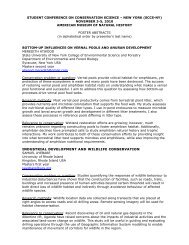Educator's Guide - American Museum of Natural History
Educator's Guide - American Museum of Natural History
Educator's Guide - American Museum of Natural History
Create successful ePaper yourself
Turn your PDF publications into a flip-book with our unique Google optimized e-Paper software.
GLOSSARYarable land: land suitable for growing cropsbiotechnology: using living biological organisms orprocesses for various purposes, including production <strong>of</strong>drugs, hormones, and genetically modified foodscalorie: a unit <strong>of</strong> energy, provided in food by carbohydrates,proteins, and fatscommodity: bulk agricultural product that can be soldand traded, such as wheat or soycuisine: a set <strong>of</strong> cooking practices and traditions, <strong>of</strong>tenassociated with a particular region or culturedomestication: altering wild plant and animals at thegenetic level by selective breeding to accentuate traitsthat benefit humansfishery: an area where fish are harvested (wild) orfarmed (aquaculture)food security: stable access to enough food and theability to prepare it in a healthy waygreenhouse gas: gases that absorb solar energy andreemit it as infrared energy that warms Earth’satmospheremetabolism: the set <strong>of</strong> chemical reactions that maintainlife within organismsorganic farming: farming that does not use syntheticfertilizers and relies on natural or mechanical methodsfor weed and pest controlselective breeding: breeding members <strong>of</strong> the samespecies for desirable traitsundernourishment: too little food for good health.Malnutrition — too little <strong>of</strong> the right kinds <strong>of</strong> nutrients —can involve under or over nourishment.THE SCIENCE OF TASTEYour tongue and mouth are filled with taste buds. Eachcell in these bundles senses a single taste — sweet, sour,bitter, salty, or umami (savory) — and sends this chemicalinformation to the brain. In order to sense flavors, yourbrain integrates information about taste, along with texture,temperature, and input from the other senses: youreyes (red drinks likely taste sweet!), your ears (celery hasto crunch!), and above all your nose. Odor molecules areinhaled through your nostrils and also pass between yourthroat and nasal cavity as you chew. These messages travelto the brain, which can tell thousands <strong>of</strong> aromas apart.All <strong>of</strong> this sensory input combines to make it possible toenjoy countless subtle flavors, like the difference betweenstrawberry and cherry jellybeans. Preferences — whetheryou like spicy foods or unusual flavors, for example — canbe shaped by many factors, including anatomy, genetics,evolution, culture, memory, and marketing.COME PREPAREDPlan your visit. For information about reservations, transportation,and lunchrooms, visit amnh.org/plan-your-visit.Read the Essential Questions in this guide to see how themesin Our Global Kitchen connect to your curriculum. Identify thekey points that you’d like your students to learn.Review the Teaching in the Exhibition section <strong>of</strong> this guidefor an advance look at the models, artifacts, and interactives thatyou and your class will be encountering.Download activities and student worksheets at amnh.org/our-global-kitchen/educators. Designed for use before, during,and after your visit, these activities focus on themes thatcorrelate to the New York State Science Core Curriculum.Decide how your students will explore the Our GlobalKitchen exhibition.• You and your chaperones can facilitate the visit using theTeaching in the Exhibition section <strong>of</strong> this guide.• Your students can use the student worksheets to explorethe exhibition on their own or in small groups.• Students, individually or in groups, can use copies <strong>of</strong> themap to choose their own paths.CORRELATIONS TO NATIONAL STANDARDSYour visit to the Our Global Kitchen: Food, Nature, Culture canbe correlated to the following standards.National Curriculum Standards for Social StudiesThematic Strands: 1. Culture; 3. People, Places, and Environments;7. Production, Distribution, and Consumption; 8. Science,Technology, and Society; 9. Global ConnectionsA Framework for K-12 Science EducationCrosscutting Concepts: Patterns; Cause and Effect: Mechanismand Explanation; Scale, Proportion, and Quantity; Systems andSystem Models; Energy and Matter: Flows, Cycles, andConservation; Structure and Function; Stability and ChangeScience Practices: Asking Questions and Defining Problems;Analyzing and Interpreting Data; Constructing Explanationsand Designing Solutions; Engaging in Argument from Evidence;Obtaining, Evaluating, and Communicating InformationCore Ideas: LS3.A: Inheritance <strong>of</strong> Traits; LS3.B: Variation <strong>of</strong>Traits; LS4.C: Adaptation; LS4.D: Biodiversity and Humans;ESS3.A: <strong>Natural</strong> Resources; ESS3.C: Human Impacts on EarthSystems; ETS2.B: Influence <strong>of</strong> Engineering, Technology, andScience on Society and the <strong>Natural</strong> World
MAP <strong>of</strong> the Exhibition
















